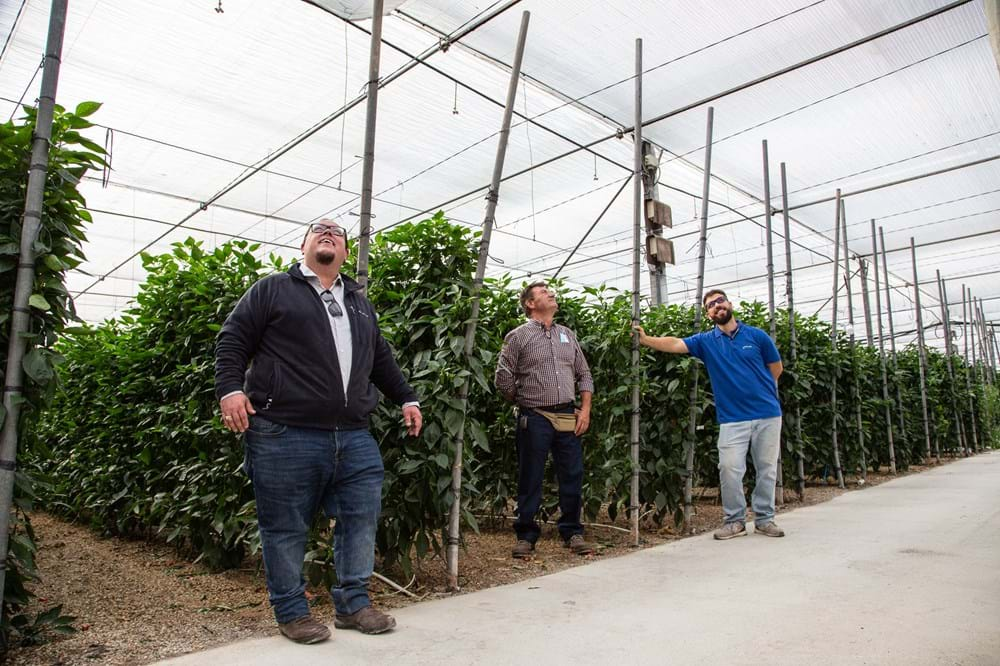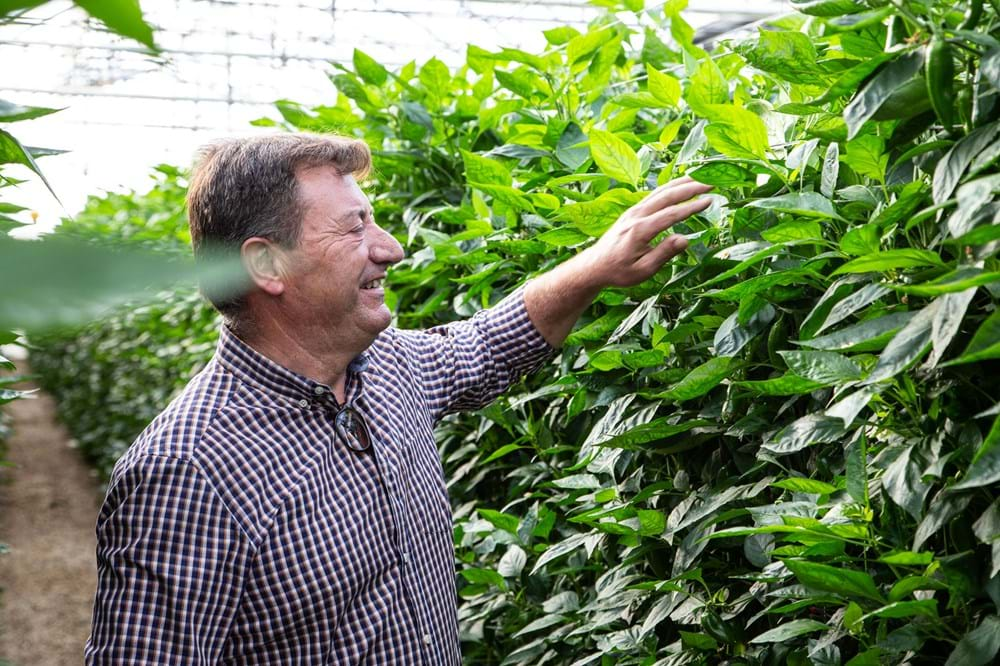The Baños family, a pioneer in using Svensson screens
Located among the greenhouses of Western Almería in El Ejido, the family-owned company Natural Baños has been a pioneer in using Svensson screens in the province for 18 years.
Crossing the sea of plastic, we reach Natural Baños. We encounter the friendly smile of Nelson Pérez, Svensson's climate consultant, who always looks after customers and makes sure that the screens work correctly and that their needs are met. José Baños greet us, the first generation of the family-run company Natural Baños and his son, Daniel Baños, the second generation and to whom he is handing over leadership.
Together, we walk towards one of their greenhouses, where they mainly produce pepper. José Baños tells us his story about being a pioneer in using Svensson screens, a technology that sees increasing use in the province of Almería.
José, tell us a bit about the history of your crops in El Ejido.
In summary—it isn't easy to summarize when you have dedicated your life to something you love a lot like the Earth—we began with agriculture using plastics in a traditional greenhouse, where we were growing pepper. We were victims of the aggressiveness of the pests, which was very damaging for the crops.
In 2002, I set out to create a better-equipped greenhouse that was more hermetic so that I could manage the whitefly and thrip pests. Therefore, we made a multi-tunnel greenhouse that lets you store more tools than in a sloping-roof type greenhouse.

When did you begin to work with Svensson?
When we were building the greenhouse, the manufacturer put me in contact with the various available companies. The screen that impressed me the most was Svensson's XLS 14. I removed it last year to replace it with a new one, and it has been working perfectly for 17 years.
We installed the Svensson XLS 14 thermal screen and some heaters as a heating tool, which gave me greater peace of mind for cultivating peppers at that time. We have used the screen thermally in night-time mode in the fall, winter, and spring months. We have also used it in shade mode in the spring, summer, and beginning of fall. In Almería, it is great to have a screen to automatically open or close with your computer or even manually anytime you wish to do so.
How did you become a pioneer in using this technology?
In previous years, the screens have seen very little use in Almería, although it seems that people are increasingly opting for this type of technology. A computer that manages it makes it easy for you to use the tool to optimize the screen's resources. It's something as simple as being thankful for the sunshine you are getting now, but it's also the case when you prefer to have shade to cover in after a while.
What was the impact of the first Svensson screen that you used?
The three main benefits of the screen that we took advantage of since we started using the first one (XLS 14) in 2002 were the following:
- Being able to increase the greenhouse temperature at night by two degrees without heating nor consuming fuel was a bonus. You are adding those extra two degrees with an initial investment but without energy costs.
- There were also gains if you had heating equipment. You covered the greenhouse at a lower height, limiting the heating area. In other words, we reduced the cubic meters of the space that we had to heat when we started the heater, which meant additional savings. Pepper has a greater need for heating, so we made more investments in the heating supply. By reducing the area to be heated, it was cheaper to heat the greenhouse.
- The benefit was the option of using it as shade in 6 months between spring, summer, and fall.
These are the three main benefits that we obtained from the screen. The crops that we currently have here are mini peppers, but you can make the most of any crop.
After explaining to us when this new technology began to be incorporated into their crops, José Baños looks at his son, Daniel Baños, the second generation of the Baños company. He has carefully instructed every technical matter to keep the company operating at peak performance by offering the best products from their crops. We begin our conversation with him.

Daniel and José Baños
Daniel, please tell us what it means for you to be the second generation in the company.
I am proud of my father's knowledge, which works well year after year, even though we are always learning. And I feel happy, thrilled because you are doing what you like, and it challenges you personally and professionally at the end of the day. It is also a challenge because times change, the climate changes, and you have to try to deal with it in the best manner possible.
Why did you choose Svensson's Harmony 3845 screen? What was the reason for the change?
We agreed upon with the manufacturer's technician because the XLS 14—the screen we previously used—had two aluminum strips and one polypropylene strip (Nelson smiles, impressed at how they remember these details). The factory no longer recommended them since they had other, more advanced screens to optimize our crops' yields better. Nelson gave me advice, closely studying the crop that we were growing and our objective. He told me: "You need to install the Harmony 3845 screen".
Nelson, what made you determine that the Harmony 3845 screen was the right one for the Baños family?
First of all, the Harmony 3845 screen breaks the sunlight's entry angle, something that not every screen does. Furthermore, our screens are the ones that provide the highest level of transpiration worldwide, and our screens have the highest Hortiscatter level (light distribution) on the market.
The sunlight diffusion effect is very pronounced when the screen is deployed. Due to how the Baños farmers produce, we were interested in having a versatile screen for working in the winter, preserving the energy savings with the humidity, and adequately managing it based on temperatures, sunlight, and humidity in the summer.


What difference do you notice in the crops after incorporating Svensson's new Harmony 3845 screens?
Night-time temperatures have improved, both the minimum and average. Humidity during the entire day has also improved. The advantage of having a screen is that we can open it whenever we want based on what the crop needs, whereas if you only have a double-roof, you always keep it closed and miss out on light, air exchanges, and you do not have any control.
You can also have a reduced water deficit at night, which gives you more significant crop activity.
Adding all these factors, crop yields are multiplied 24 hours a day.
How is your relationship with Svensson?
We are delighted. We just began working with Svensson again on a new project. We mainly like Nelson's assistance, knowledge, and friendship, the company's visible face here in Spain. He is an excellent professional that offers advice and cooperation.
Before saying farewell, Nelson—Svensson's climate consultant—tells us something exciting about the Baños family's cultivation systems:
In addition to the multi-tunnel systems on their farm, we will also begin to improve traditional production systems, enhancing both insect protection and the climatic variables of the sloping-roof type greenhouses. We are creating a group with our farmers, an expansion to use Svensson's new Xsect anti-insect screens. We have impressive results against infestations in addition to improving the climate together with our screens. The goal is to make the most of the power of Almeria's traditional greenhouses.
So, we have already successfully adapted the components of hi-tech greenhouses—like the screens—to traditional sloping-roof type greenhouses. It is an essential step for developing traditional greenhouses with dynamic climate control and improved pest protection.